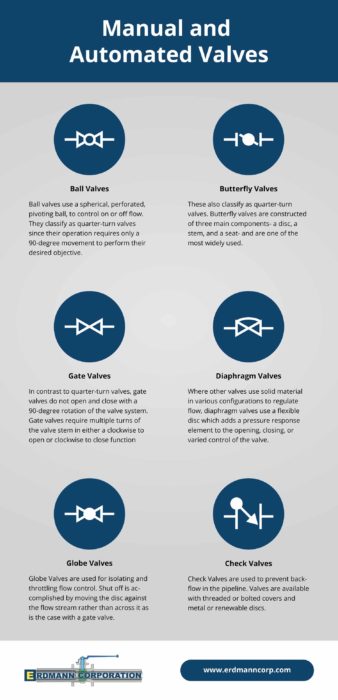Valve Product Checklist
Erdmann Corporation will work closely with you to define your valve needs and specify the product to meet those needs. Use the list below as a guide to some of the many factors needed in making an important valve purchase. Knowing this criteria will help you select the best valve for the particular application.
Application
- Media Being Handled, e.g., liquid, gas, slurry or solid
- Corrosiveness of Media, e.g., pH, concentration
- Corrosiveness of Atmosphere
- Flow(velocity, capacity, Cv, direction
- Pipe Size
- Media Temperature (max-min)
- Pressure
- Maximum operating pressure
- Maximum differential pressure
- Operation,e.g., manual/automatic, on-off throttling
- Installation Constraints
- Envelope Dimensions
- Weight
- Accessibility
- Conformance to Appropriate Standards, e.g., API, ASTM, ANSI, FM, UL, OSHA, etc.
- Tightness of Shutoff Required
Valve Requirements
- Type of Valve,e.g., ball, butterfly, gate, check, control, globe, plug, relief, regulator, pinch, diaphragm, etc.
- Valve Size
- End Connections,e.g., screwed, flanged/lugged, wafer, butt-weld, mechanical joint, etc.
- Materials of Construction, e.g., carbon steel, resins, steel or other alloys, cast iron, etc.
- Body
- Trim
- Seats
- Bolting
- Frequency of Operation
- Packing (type and material)
- Special Requirements, e.g., stem/shaft extensions, locking device, position indicator, jacketing
Valve Actuation
- Type, e.g. manual, electric, pneumatic, hydraulic
- MotionRequired
- Rotary, e.g., quarter-turn, multi-turn
- Linear
- Mode of Operation
- Double-acting
- Spring return (spring-to-closed, spring-to-open)
- Required Valve Operating Thrust or Torque
- Power Supply, e.g., voltage, available air supply
- On/Off, Throttling or Proportional Control
- Corrosive Resistance (materials, coating, tubing)
- Speed of Operation
- Frequency of Operation
- Special Requirements, e.g., tagging, testing
- Accessories, e.g., limit switches, positioner, solenoid, valve, transducers, manual override
Service Requirements
- Testing
- Source Inspection
- Availability of Replacement Valves, Actuators, or Parts
- Documentation,e.g., certified prints, dimension drawings
- Installation and Maintenance Instructions
- Delivery Requirements, e.g., timing packaging
- Availability of Engineering Service, e.g., application, field, factory


 Valve actuators are mechanical devices that allow for remote and automatic control of valves, eliminating the need for direct human involvement. Although relatively simple in design, these devices play a vital role in the overall efficiency and safety of process systems. With the significant variability in valve and actuator designs, taking the time to research and identify an actuator that fits your system’s specific requirements is critical for ensuring a smooth and successful operation. Some of these factors include:
Valve actuators are mechanical devices that allow for remote and automatic control of valves, eliminating the need for direct human involvement. Although relatively simple in design, these devices play a vital role in the overall efficiency and safety of process systems. With the significant variability in valve and actuator designs, taking the time to research and identify an actuator that fits your system’s specific requirements is critical for ensuring a smooth and successful operation. Some of these factors include: The following factors should be considered when determining the ideal actuator size for your application:
The following factors should be considered when determining the ideal actuator size for your application:

 Actuators are mechanical or electromechanical devices that use a power source to drive controlled movement and positioning of industrial and mechanical equipment. While there is a wide range of actuators available, they can generally be categorized into two basic classifications:
Actuators are mechanical or electromechanical devices that use a power source to drive controlled movement and positioning of industrial and mechanical equipment. While there is a wide range of actuators available, they can generally be categorized into two basic classifications: